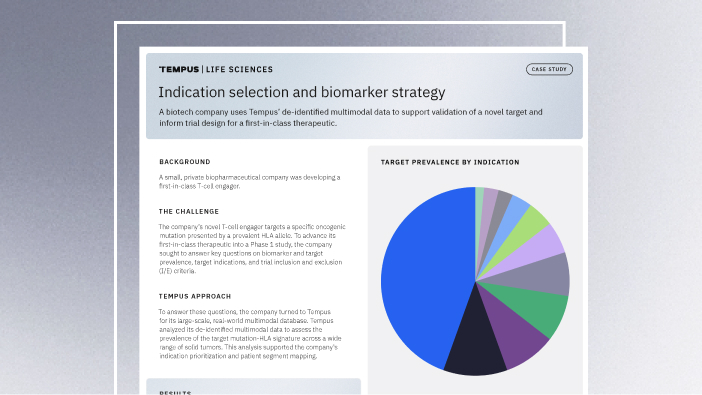-
PROVIDERS
New MRD Medicare Coverage for Select Indications*
*When coverage criteria are met. Additional criteria and exceptions for coverage may apply.
-
LIFE SCIENCES
ENROLL NOW
Tempus’ patient-derived organoid screens
Evaluate the efficacy of your preclinical compounds using fixed organoid panels designed for diverse therapeutic applications -
PATIENTS
It's About Time
View the Tempus vision.
- RESOURCES
-
ABOUT US
View Job Postings
We’re looking for people who can change the world.
- INVESTORS
11/15/2024
Q&A: AI algorithms in cardiology: From research to clinical practice
In a recent webinar hosted by Tempus, experts gathered to discuss the integration of AI algorithms into cardiology, focusing on the journey from research to practical application in patient care.
Authors
Dr. David Ouyang, MD
Assistant Professor, Cedars Sinai Medical Center
Department of Cardiology, Assistant Professor-in-Residence, UCLA

Dr. Brandon Fornwalt, MD, PhD,
Senior Vice President of Cardiology at Tempus

Dr. John Pfeifer, MD, MPH
Vice President of Clinical Cardiology at Tempus

Assistant Professor, Cedars Sinai Medical Center
Department of Cardiology, Assistant Professor-in-Residence, UCLA

Dr. Brandon Fornwalt, MD, PhD,
Senior Vice President of Cardiology at Tempus

Dr. John Pfeifer, MD, MPH
Vice President of Clinical Cardiology at Tempus

The panel featured Dr. Brandon Fornwalt, Senior Vice President of Cardiology at Tempus, Dr. David Ouyang, Cardiologist and Assistant Professor at Cedars-Sinai and UCLA, and Dr. John Pfeifer, Vice President of Clinical Cardiology at Tempus. The conversation centered on the potential of AI to close diagnostic gaps and improve patient outcomes, particularly in the context of conditions like atrial fibrillation (AFib) and pulmonary hypertension.
|
“There’s so much information in the clinical data that we’re not yet fully leveraging… I think of it like an iceberg. We’re only using a small portion of the available data for a specific indication, but AI has the potential to uncover additional value and help flag patients earlier.” – Dr. David Ouyang, Assistant Professor at Cedars-Sinai and UCLA |
Can you explain the challenge of underdiagnosis and undertreatment in cardiology? |
| David: Diagnosis is the cornerstone of medicine. For conditions like AFib, which can be intermittent and subtle, it’s challenging to diagnose based on non-specific symptoms. AI can help us leverage the wealth of clinical data we have to identify these conditions earlier. The art of medicine fundamentally comes down to diagnosis, and AI has the potential to uncover additional value and help flag patients earlier. |
How can AI and data-driven approaches help with these challenges? |
| John: Clinicians are inundated with information. AI can help organize and interpret this data, allowing for quicker and more accurate diagnoses, which is crucial given the limited time doctors have with patients. In a busy clinical practice, clinicians may only have 15 minutes with a patient, and so much can happen between visits. Patients could have been admitted to the hospital, had multiple tests—there’s just so much information to sift through. AI can help us organize that data and draw insights, making it easier to get to a diagnosis faster. |
What is the potential impact of ECG-based algorithms in cardiology? |
| David: The 12-lead ECG is a ubiquitous tool in healthcare. AI can help us identify risk factors and conditions from ECG data that might otherwise be missed, especially since ECGs are often reviewed well after they’re taken. The challenge is that the ECG might be interpreted by a cardiologist days or even weeks after it’s done, which could be too late to act on something important. There’s also hindsight bias—when patients come into the ICU or present with more severe symptoms, we might realize in retrospect that there were signals on the ECG from months ago that could have warned us of an issue earlier. |
What considerations go into choosing conditions like AFib and pulmonary hypertension for AI algorithm development? |
| John: We focus on significant health problems where early diagnosis can drastically improve outcomes. Both AFib and pulmonary hypertension have effective treatments available, making early detection critical. About 800,000 strokes occur in the U.S. each year, and a quarter of them are related to AFib. Many patients don’t know they have AFib until they have a stroke. If we could diagnose AFib earlier, we may be able to prevent strokes, which is always better than treating them after they happen. |
What are the challenges in building these algorithms, and how do you ensure they’re accurate? |
| David: The balance between data quantity and quality is key. Healthcare data can be noisy, so it’s essential to have accurate labels and controls. Retrospective and prospective validations are necessary to ensure the algorithm’s effectiveness across diverse patient populations. At a high level, there’s always tension between having the best labels versus having the most data. AI generally wants as much training data as possible, but healthcare data is often imperfect. Diagnostic codes are sometimes used for billing rather than clinical precision, and that can create noise in the data. The key is finding the right patients and the right controls, and that requires both technical and clinical expertise. |
|
“You might feel like you’re at the finish line after regulatory approval, but you’re actually just getting started. Getting clinical adoption is challenging. Making the AI insights actionable and easy to use is key to ensuring we actually improve patient outcomes.” – Dr. John Pfeifer, Vice President of Clinical Cardiology at Tempus |
How do you integrate AI tools into clinical workflows effectively? |
| John: Integration is crucial. The AI must fit seamlessly into existing workflows, providing clear value without adding complexity. It should be actionable and easy to use to ensure it improves patient outcomes. That’s where the real work begins. You might feel like you’re at the finish line after regulatory approval, but you’re actually just getting started. Getting clinical adoption is challenging. Clinicians are extremely busy, so it’s vital to integrate the AI into existing workflows in a way that doesn’t add more time or complexity to their day. |
Can you share insights from your experience with prospective studies to bridge the gap between research and practice? |
| David: In our prospective studies, we’ve learned that the key to bridging the research-practice gap is to integrate AI tools in a way that minimizes disruption to clinicians’ workflows. By embedding AI outputs directly into the software that clinicians are already familiar with, we avoid adding extra steps to their routine. It’s also critical to prepare the healthcare system to act on the AI’s findings, whether that means diagnosing more patients or managing new treatments, ensuring the clinic can effectively utilize the insights provided by the AI. |
How does Tempus’ technology address workflow challenges? |
| John: Tempus’ technology, particularly Tempus Next, is designed to streamline clinical workflows by efficiently identifying patients at risk and notifying clinicians of where a patient may be eligible for guidelines based care. Recognizing the diversity in healthcare practices, Tempus emphasizes customization of its tools to align with the unique processes and challenges of each healthcare setting. By working in close collaboration with healthcare providers, Tempus ensures that its technology not only integrates smoothly into existing systems but also enhances the overall efficiency and effectiveness of patient care management. |
In Summary
This webinar illuminated Tempus’ commitment to advancing cardiology through AI algorithms, focusing on the critical transition from research to clinical application. The expert panelists discussed the challenges and strategies for diagnosing and treating conditions like AFib and pulmonary hypertension earlier and more effectively.
They emphasized the necessity of integrating AI into clinicians’ existing workflows without adding complexity, the rigorous validation of algorithms across varied patient demographics, and the collaborative efforts between Tempus and health systems to navigate the implementation of this technology. The conversation underscored the potential of AI to transform patient care, making it more proactive, personalized, and efficient.
-
12/11/2025
Driving enterprise value with RWD
Hear from biotech CEOs and VC leaders as they discuss how real-world data can inform strategic decision-making in biotech companies.
Watch replay -
11/11/2025
A new era of biopharma R&D: The TechBio revolution—realities and the next frontier
Join Tempus and Recursion leaders to explore their strategic TechBio partnership. Learn how they use AI and supercomputing with petabytes of data to accelerate drug discovery and development. See the impact on biopharma R&D's future.
Watch replay -
11/14/2025
Validating a novel target and informing trial design for a first-in-class therapeutic
Discover how a biopharma company used Tempus’ de-identified multimodal data to support validation of a novel target and inform trial design for a first-in-class therapeutic.
Read more


